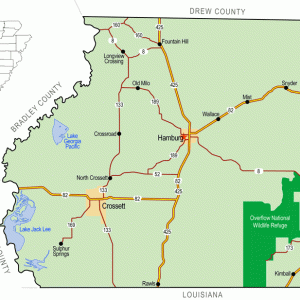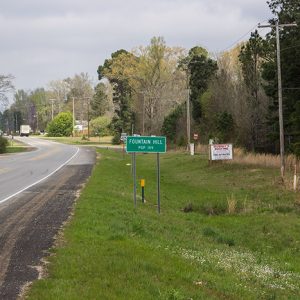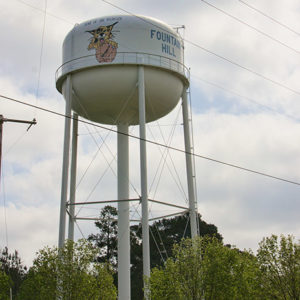calsfoundation@cals.org
Fountain Hill (Ashley County)
| Latitude and Longitude: | 33°21’28″N 091°51’01″W |
| Elevation: | 194 feet |
| Area: | 0.57 square miles (2020 Census) |
| Population: | 108 (2020 Census) |
| Incorporation Date: | September 10, 1921 |
Historical Population as per the U.S. Census:
|
1810 |
1820 |
1830 |
1840 |
1850 |
1860 |
1870 |
1880 |
1890 |
1900 |
|
– |
– |
– |
– |
– |
– |
– |
– |
– |
– |
|
1910 |
1920 |
1930 |
1940 |
1950 |
1960 |
1970 |
1980 |
1990 |
2000 |
|
– |
– |
215 |
267 |
320 |
230 |
266 |
352 |
195 |
159 |
|
2010 |
2020 |
|
|
|
|
|
|
|
|
|
175 |
108 |
|
|
|
|
|
|
|
|
Fountain Hill is a town on U.S. Highway 425 in northern Ashley County. The town has been a center for agriculture and the timber industry and remains supportive of both industries in the twenty-first century.
The region that would become Ashley County has been inhabited for thousands of years. When the region first became part of the United States, it was considered Quapaw land, although the Quapaw villages were farther to the north. Quapaw ceded their right to the land in 1818, and settlers began to arrive from Georgia, North Carolina, and South Carolina. James Norris farmed the land between the two springs for which the town was named. He established a cotton gin and a grist mill on the hill. Elisha Kirkpatrick was one of the first merchants in the area. Several members of the Denson family also acquired land near Fountain Hill during the 1840s. A post office was established at Fountain Hill in 1846, when it was still in Bradley County. The settlement became part of Drew County that same year, and then became part of Ashley County when that county was formed in 1848. A private school called the Fountain Hill Academy opened in 1851.
Agriculture in Ashley County was very diversified before the Civil War. Products included rice, tobacco, beeswax, and sweet potatoes, as well as timber and cotton. By 1860, there were eight sawmills operating in the county. Residents of the county supported the Confederacy during the war.
A public school was organized in Fountain Hill in 1896. An electric railroad connecting Cremer Hill (Ashley County), Crossett (Ashley County), Fountain Hill, and Monticello (Drew County) was proposed in 1912 by the Crossett, Monticello and Northern Railroad, but the line was never built. The school burned down in 1917 or 1918, and classes were held in the Methodist church until a new two-story schoolhouse was completed in 1919. The timber industry grew in the area in the early years of the twentieth century, and Fountain Hill incorporated as a town in 1921.
A new brick schoolhouse was built in 1930, and several rural school districts were consolidated into the Fountain Hill School District. Later in the decade, additional buildings were added through the work of the Works Progress Administration (WPA), including an agriculture building in 1938 and a home economics cottage in 1940. A new school was built in 1974, and bricks from the old school were used to veneer Eden Baptist Church south of Fountain Hill.
The Fountain Hill School District was consolidated into the Hamburg (Ashley County) school district in 2004. Fountain Hill has a small downtown district with a branch of the Bank of Crossett and several stores. The town also has a Baptist church and a Missionary Baptist church. In 2010, the population of Fountain Hill was 175, including 110 white residents and fifty-six African-American residents.
The most famous person born and raised in Fountain Hill was Joseph Jackson, whose children include musicians Janet Jackson and Michael Jackson, as well as the other members of the Jackson Five.
For additional information:
Denson, Frank. “Early Schools in Fountain Hill.” Kin Kollecting 14 (Spring 2000): 23–29.
Etheridge, Y. W. History of Ashley County, Arkansas. Van Buren, AR: The Press-Argus, 1959.
Steven Teske
Butler Center for Arkansas Studies
 Ashley County Map
Ashley County Map  Fountain Hill
Fountain Hill  Fountain Hill Water Tower
Fountain Hill Water Tower 




Comments
No comments on this entry yet.